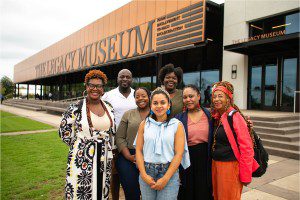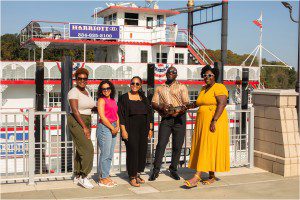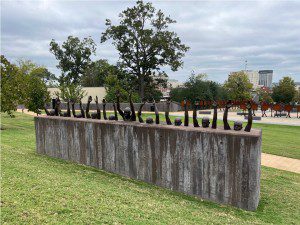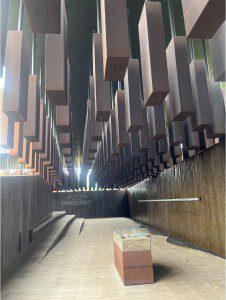News and Insights
From Hawaii to Alabama: A Journey of Radical Reconnection
February 29, 2024
Alty Falvey, FINN Senior Account Executive in our Hawai’i office, shares with us about her trip to Alabama, where she visited the Legacy Museum, Selma and Tuskegee with The Pōpolo Project, a nonprofit organization in Hawaii that redefines what it means to be Black in Hawaii and across the Pacific by creating spaces and opportunities for people to radically reconnect to themselves, communities, ancestors, and the land.
The Pōpolo Project was provided with a grant for board members and community members to travel from Hawaii to Alabama, to visit The Legacy Museum and The National Memorial for Peace and Justice.

Background on the Legacy Museum
The Legacy Museum and the National Memorial for Peace and Justice were created by the Equal Justice Initiative to not only tell the story of how destructive and traumatizing slavery was but to also tell the story of how it evolved.
Now, why would a law office open a racial history museum?
After decades of fighting injustice in the criminal justice system, standing in courthouses with Confederate monuments out front and visiting prisons where Black prisoners were laboring in fields that were once worked by enslaved people, Equal Justice Initiative advocates realized that slavery, racial terror, and Jim Crow segregation are still palpable in the American South, in Federal lawmaking and the national rhetoric.
EJI began the Race and Poverty project in 2008, which included a public education campaign to change the narrative about modern criminal justice issues by including this historical perspective. In 2018, The Legacy Museum and The National Memorial for Peace and Justice opened to serve as spaces to address the legacy of slavery, which affects many issues today.
More than 12 million African men, women, and children were kidnapped and sold into slavery in the Americas. When the Transatlantic Slave Trade was abolished by Congress, the increasing demands for enslaved Black labor were fulfilled by the domestic slave trade which moved enslaved people from the upper to the lower South.
From 1810 to 1860 Montgomery, Alabama became one of the most active slave trading sites in the country due to its proximity to the Alabama River, which allowed for hundreds of enslaved people to arrive in Montgomery via steamboat every single day. In warehouses throughout downtown Montgomery, which still stand today, enslaved people were imprisoned alongside animals and bales of cotton while they awaited an unknown fate and possible separation from family and loved ones.

This is a picture of some of us standing by the Montgomery riverfront, which is a site where our enslaved ancestors were bought and sold, and this was incredibly emotional. And we shared in, mele, song to honor our ancestors, as well as made sure to laugh to uplift them.
Harriet Tubman once said, “Slavery is the next thing to hell.”
Although slavery in America was officially abolished in 1865, the narrative of racial inferiority denying Black people’s humanity was not addressed. The psychological and physical trauma of enslavement caused enslaved people to attempt to escape to the free North. However, slave owners would post bounties to entice slave catchers and law enforcement to return the fugitive slaves by any means necessary. Black families were devalued and about half of all enslaved people were separated from a spouse or parent.
After the Civil War, desperate notices seeking family were posted in newspapers. However, very little was done to help formerly enslaved families reunite and most never found their family members again.

Following the Civil War, Black folks suffered decades of racial terrorism and lynching. White Southerners who had once been supporters of slavery and defenders of the Confederacy, re-established the racial hierarchy through racial terror, lynching and other brutal violence, while national leaders did little. Between 1830 and 1860 Southern mobs killed an estimated 130 white individuals, and at least 400 enslaved Black people.
Southern lynchings of African Americans were often extremely brutal, with victims being burned, tortured, mutilated, and even decapitated. The lynching of Black Americans was terrorism and was often for offenses like not yielding the road to a white driver or fathering a child with a white woman.

The National Memorial for Peace and Justice is an outdoor square, created to honor all victims of racial terror and lynchings. The Square acknowledges the horror of being tortured and killed, while thousands watched and cheered.
I’d like to share a poem called Invocation by Elizabeth Alexander that was in the square:
“The wind brings your names.
We will never dissever your names
nor your shadows beneath each branch and tree.
The truth comes in on the wind, is carried by water.
There is such a thing as the truth. Tell us
how you got over. Say, Soul look back in wonder.
Your names were never lost,
each name a holy word.
The rocks cry out—
call out each name to sanctify this place.
Sounds in human voices, silver or soil,
a moan, a sorrow song,
a keen, a cackle, harmony,
a hymnal, handbook, chart,
a sacred text, a stomp, an exhortation.
Ancestors, you will find us still in cages,
despised and disciplined.
You will find us still mis-named.
Here you will find us despite.
You will not find us extinct.
You will find us here memoried and storied.
You will find us here mighty.
You will find us here divine.
You will find us where you left us, but not as you left us.
Here you endure and are luminous.
You are not lost to us.
The wind carries sorrows, sighs, and shouts.
The wind brings everything. Nothing is lost.”
Due to racial terror, millions of Black people were forced to leave their homes in the South as refugees and exiles in what is referred to as The Great Migration. Black Southerners who survived racial terror were forced to live under Jim Crow laws for nearly a hundred years. Jim Crow laws legalized racial segregation and legitimized anti-Black racism. Under Jim Crow, African Americans were second-class citizens.
Today, Montgomery is known as both the Cradle of the Confederacy, for it was in Montgomery that the Confederate States announced the secession, and the birthplace of the Civil Rights Movement.
The Montgomery Bus Boycott, which began 4 days after Rosa Parks was arrested, is seen as the first large-scale U.S. demonstration against segregation with about 40,000 Black bus riders, the majority of Montgomery’s bus riders, boycotting the entire system. In the winter, choosing to walk to work and organize together in churches to arrange for carpools, helping each other in any way they could.
The Selma to Montgomery marches to ensure that Black Americans could exercise their right to vote, led to the passage of the Voting Rights Act in 1965, after nearly a century of unconstitutional discrimination. At the time of the Marches, only 2% of Selma’s population that was eligible to vote had actually been able to register.

We met with elders from the Tuskegee Macon County Community Foundation, which is a nonprofit organization, led by the former Mayor of Tuskegee, Dr. Lucenia Williams Dunn. She is the woman with the beautiful smile in the middle, with the black and white shirt. TMCCF is focused on enhancing the quality of life in rural areas as well as in other communities facing economic and social challenges.
We built community with our elders by sharing stories, poems and songs, allowing us to radically reconnect and reframe history with Black survival, resilience and joy. We also had some of the best fried chicken and potato salad I’ve ever had!
Ida B. Wells once said, “The way to right wrongs is to turn the light of truth upon them.”
Our history is heavy, and it is a lot, but it is important to fully understand our past, so that we can work to have a more just and equitable future.
